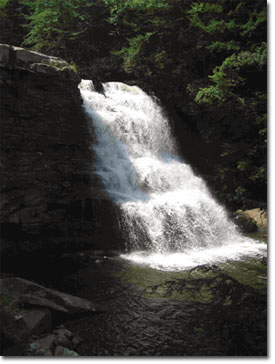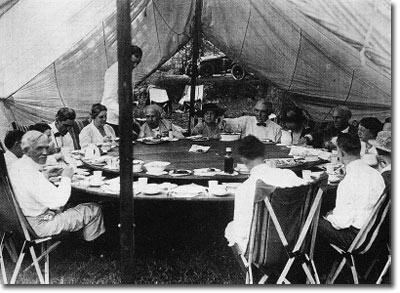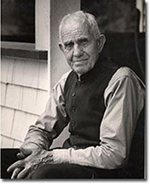Vagabonds Remembered for Work, but Loved Nature
By Francis Champ Zumbrun
Note: This is the sixth in a series of articles covering a time in the summer
of 1921 when Henry Ford, Thomas Edison, and Harvey Firestone camped for two
weeks in western Maryland. This article finds the Vagabonds, a term the wealthy
captains of industry called themselves when they camped together at “Camp
Harding” (along Licking Creek, about six miles east of Hancock, in Washington
County) where they stayed from July 21 to July 27, and at present day Swallow
Falls State Park, from July 27 to July 31.
Question to consider (the answer is at the end of this article): What came first
to western Maryland, The Vagabonds or Deep Creek Lake?
“It often seemed to me that we were a luxuriously equipped expedition
going forth to seek discomfort - dust, rough roads, heat, cold, irregular hours,
accidents. But discomfort, after all, is what the camper-out is unconsciously
seeking - we react against our complex civilization and long to get back for a
time to first principles.”
- John Burroughs
 It was true the Vagabonds, these “gentlemen campers,” were not exactly roughing
it; but, it was also true these captains of industry did go without some of
comforts that they were accustomed to at home. Anyone finding them camping at
Muddy Creek Falls in the summer of 1921 would have found the Vagabonds carrying
much more camping gear than when they first began camping together in 1915.
It was true the Vagabonds, these “gentlemen campers,” were not exactly roughing
it; but, it was also true these captains of industry did go without some of
comforts that they were accustomed to at home. Anyone finding them camping at
Muddy Creek Falls in the summer of 1921 would have found the Vagabonds carrying
much more camping gear than when they first began camping together in 1915.
Their entourage, consisting of about 40 people, was much larger as this was the
first time their wives traveled and camped with them. In addition to family
members, six support staff traveled with them to drive trucks, cook, set-up and
break-down their camping gear, and be a general camp “roustabout.”
Edison was probably the unhappiest of the group because their camping equipment
was becoming more elaborate and cumbersome. Edison took great joy telling his
friends stories about his adventures with the Vagabonds, his close encounters
with nature, and toughing-it-out in the great outdoors each summer.
Now that their wives were camping with them, the Vagabonds were less likely to
drive in the back woods along rough, dust-covered roads with little or no
traffic, roads that Edison loved exploring.
 Interestingly, Edison overlooked the fact that he too brought advanced camping
gear, the like never seen before at a campsite, including a battery-powered
radio and several strings of electrically powered light bulbs.
Interestingly, Edison overlooked the fact that he too brought advanced camping
gear, the like never seen before at a campsite, including a battery-powered
radio and several strings of electrically powered light bulbs.
Joseph Hinebaugh, with several other boys, who the Vagabonds bumped from their
Muddy Creek Falls camping spot (discussed in a previous article), visited the
famous men at their campsite and were amazed to see light bulbs strung all
around the camp connected to and powered by an automobile battery.
The Vagabonds treated their youthful visitors to sweets each time they visited
their camp. While eating their candy, they must have been impressed with the
high-end camping gear at the Vagabonds campsite: the Lincoln refrigerated
kitchen truck that carried state-of-art cooking gear including a portable
gasoline cooking stove, although the Vagabonds favored their meals cooked on a
grill over a wood-fueled campfire, and the large, twenty-feet square dining
tent, enclosed with mosquito netting.
If the boys peeked into the dining tent they would have seen a large circular
dining table about nine feet in diameter, and on top, a large lazySusan. This
table could seat twenty people around it. The lazySusan made it easy to
distribute the servings of food and condiments around the table.
The boys would have also noticed the army-styled canvas sleeping tents, each
about 10-feet square in size with mosquito netting sewn into the flaps. Each
family had their own tent, identified with a name-placard placed at the
entrance.
The youth would have also been impressed with the many wooden, striped
canvas-backed chairs making a ring around the campfire pit. The Vagabonds
designed the kitchen table and chairs to fold for easy storage in the equipment
and camping supply truck.
 Abraham Lincoln “Link” Sines, well known Garrett County forest warden, and his
brother Henry, visited the Muddy Creek Falls campsite and told stories to the
Vagabonds about the natural and cultural history of the area, the role John
Burroughs played on past camping trips up to his death earlier that year.
Abraham Lincoln “Link” Sines, well known Garrett County forest warden, and his
brother Henry, visited the Muddy Creek Falls campsite and told stories to the
Vagabonds about the natural and cultural history of the area, the role John
Burroughs played on past camping trips up to his death earlier that year.
A photograph survives showing Henry Sines talking to Henry Ford at Muddy Creek
Falls. The photograph shows Ford sitting back in his chair, being very
attentive, listening with great interest, and hanging on to every word Sines
spoke.
To fill in for the great naturalist Burroughs’s must have been rather
intimidating for the Sines brothers. Burroughs, a famous writer, looked at
nature as a treasure, full of “acres of diamonds,” rich in wonder and awe,
observations that he convincingly wrote about in his many inspirational nature
books. Burroughs wrote that the natural world revealed its magic and mystery to
anyone who had the eyes to see and the ears to hear.
Link Sines, a master woodsman himself, first met the Vagabonds in 1918 when they
previously passed through Garrett County. Link later recalled, “Ford loved
anything mechanical. He was constantly looking for items to add to his
collection in Detroit. Firestone liked to fish. Edison was either reading a book
or tinkering with his Packard. Burroughs knew more about trees and plants than
anyone I ever met.”
However, the Sines brothers did not have to worry about formality when they were
with the Vagabonds. Ford, Firestone, and Edison encouraged the Sines brothers
and others who visited their campsite to relax. Edison would say: “There are no
misters in this camp. Just call us by our first names…I’m Tom to you.” Visitors
remembered that the atmosphere around the Muddy Creek Falls camp was casual,
with friendly conversation, and a place where laughter prevailed.
At night, everyone looked forward to sitting around the campfire, telling
stories and jokes. Edison was the master of timing the punch line when telling a
joke, causing everyone to burst out in laughter.
Edison was hard-of-hearing. When it became Ford’s turn to tell a joke, he would
bring a piece of paper out from his pocket his secretary had typed earlier. Ford
would open up the paper and pass it on to Edison to read aloud, and after
laughter rang out, Edison would promptly pass the paper back to Ford, who
immediately ripped it up to avoid telling the same joke twice.
Answer to question: The Vagabonds came first, camping at Muddy Creek in 1921.
Deep Creek Lake did not exist then. In 1925, The Pennsylvania Electric Company
completed the construction of the hydro-electric dam, affecting Deep Creek, a
tributary of the Youghiogheny River, the lake not filling to capacity until
1929.
Photographs:
Photo of Muddy Creek Falls
Photo of Abraham Lincoln Sines, courtesy of
The Committee for
Maryland Conservation History.
Acknowledgements:
Retired Maryland State Forester Francis Champ Zumbrun, author, was the Manager of Green Ridge State Forest.
This is the sixth part of an occasional series about Thomas Edison,
Henry Ford and Harvey Firestone’s travels to Western Maryland,
originally published in the Cumberland Times News.
Back to Travelers Page